Premna Is a good plant bonsai. Regular cutting and pruning makes the plant a Bonsai.
Fundamental way of growing Bonsai. Growing Bonsai plants explained in a simple way step by step with videos and photos for on line learners. Flowers and bouquet making for craft lovers and hobbyist explained in a DIY
Jul 8, 2021
How to grow Premna Bonsai Plant from cuttings
Jun 18, 2021
Making Ashoka tree as Bonsai
Making Ashoka tree as Bonsai
May 16, 2021
Ficus rumphi Bonsai on a Rock
Ficus Rumphi on a Rock
May 12, 2021
Good and Best alternative for raft tape for bending Bonsai tree branches
Good and Best alternative for raft tape for bending Bonsai tree branches
Bonsai is Art of creating beautiful Trees in shallow pots. when we are shaping or styling a plant it is necessary to bend branches. Some times bending is very difficult if it is a thick branch. Because some times branch can be brake when we use lots of stress on branch, So to make it convenient to bend a branch without hurting, a rafting material is used to rap around the branches and on wrapping material wiring can be done . Then when we are bending the branch there wont be , damage to the branch because the rapping material is covered around the branch, only some delicate cracks will be there which will heal on its own. This rapping tape is amiable on online. Other wise we can use insulation tape which is having much sticky substance. any eletrical insulation tape is also good. Another option is Banana Plant stem will bw having some dried brown fiber like thin ribbon like patches will be coving the stem. They are Having Lots of fiber inside it, that is good for wrapping around the branches. Jute cloth also can be cut in to ribbons and can be used as wrapping tape. these are safe and good options for raft material.
In this video construction tape is used to bend branches.
May 7, 2021
Buxus microphylla is plant of small leaves bushy plant. Its slow growing . Usually used for hedges and can be given a beautiful shape and challenging plant to grow as a Bonsai tree. Common nursery name of this plant is china box.
Making challenging Plant to a Bonsai is definitely a demanding work for Bonsai lovers. Plant grows up to 6.5 feet tall. Branches are strong and needs little heavy gauge wire to bend. It is having a strong wood cambium. Good for making shari and Jin on the trunk line and branches.
The most important point is this plant needs moist little alkane soil and grows well in shady place. Well drained soil is good for proper root growth. It prefers high dose of Nitrogen as fertilizer.
This is a nursery grown plant and is growing from branches. Buxus can be grown from seeds and branches.
Here Buxus is having twin trunk . Main trunk long and thin. Most of the branches were removed ,only one branch is selected and given a shape by wiring.
Then the plant is kept in a shady place with good nutritious soil which is required for the plant Buxus to have harmonious proper development.
After Six months Lower is kept and allowed to grow. Then top portion of the main trunk is removed.
Apr 29, 2021
Styling Thuja Orientalis ( Morpunkhi ) on A rock penjing
Morpunki it is also called as Thuja orientalis and also called as Platycladus. This is a good Plant for Bonsai. Thuja is of plant like cypress and ever green. In favorable conditions it can be grown as a indoor Bonsai, otherwise it is a little shade loving plant. it can be grow up to 10 to 12 feet. It is a slow growing medicinal plant. The leaves of the plant grown in flatten manner new leaves will have light fresh green color and old ones will be in dark green color.
I bought a Thuja plant from a nursery and thought of making it in to a Bonsai.
Plant Before Pruning
Apr 16, 2021
How to develop radiating roots on a peepal Bonsai.

For more development of the roots Mame bonsai is placed in a big pot with soil. watering will be done regularly. The cool soil gives more moisture to Bonsai plant. makes more development of fibrous roots and root thickening takes place.
Video gives in detail step by step of making
Apr 3, 2021
How to Graft a Branch On Bonsai tree
Grafting
Its a magic word. Many of us garden lovers feel like doing grafting on our plants and creating a different varieties. Usually many gardeners do grafting to enhance the plant by creating a new look to the plant and to produce new varieties of plants,. Another importance of grafting is to make the plant to produce more and quality fruits at a early stage. Some times grafting method gives new life to that plant by repairing a damaged area or side of the plant with a graft.
There are different methods of Grafting is there. Each method is having a specific name depending on the type of grafting. Grafting is also horticulture science perfect cut and union plants gives success.
When we are doing Grafting we have to remember there are two parts one is root stock and second is scion. Root stock is the plant which is undergoing graft and scion may be a branch of the same plant or another plant which is going to have union with root stock.
Oct 9, 2020
How To Make Fringe flower in to Bonsai
Main characters of the plant
Chinese fringe flower is a ornamental shrub grows up to 5to 6 feet. It can be pruned and can be given a shape. During the sunlight a chemical called anthocyanin is produced that gives a pleasant purple color to the leaves. The flowers of this plant will be hanging beautifully with pleasant pinkish purple color which highlights the plant when its in full bloom.
Sunlight
This plant grows well in full sunlight ,but the afternoon sunlight burns the leaves if the temperatures high and more than 35 degree centigrade, it prefers afternoon shade. Other wise plant grows well in full sunlight. Some of Bonsai artists prefers as a indoor Bonsai by placing the plant on western direction window where you get full proper sunlight. If there no proper sunlight color of the leaves of the plant changes they wont be having that stunning bright purple colour,
Soil
Loropetalum need good drainage ,organic soil for its proper growth. Fringe flowers likes acidic soil. To make soil acidic at least one third quantity peat moss to be added to your Bonsai soil. This plant needs lots of moisture in the soil , so peat moss helps to keep the moisture level constant. here i will share my Bonsai soil ingredients .My Bonsai soil consist of three parts manure one part of garden soil, one part pumice stones of 1 to 2 mm . This is normally used for all my medium size Bonsai plants.
Then for the plants like acidic soil loving plants I will add two parts of peat moss to Bonsai soil and mix them well. This is a good soil for loropetalum.
Watering
The main and important point is while growing Fringe flowers the soil should be moist all the time. During summer months water the plant morning and evening, If the temperature is high keep the plant in shady place and give a shower to the plant.
Care, Cutting and Pruning
This plant responds well to cutting and pruning. perfect time for cutting is early spring. It starts flowering during spring. Usually the plants flowers two to three times a year , before winter, spring and during summer season.
once the flowering season is over cut and prune the branches and give a shape to the plant and make it ready for next flowering season by providing it with organic fertilizers and slow releasing fertilizes. This plant can be grown from branches also . that is the advantage we can make a branch cutting to rooting during late summer before rainy season.
The main important thing to keep Loropetalum healthy is give proper sunlight. too much afternoon sunlight or too much shade makes the plant to loose its bright purple color of leaves.
Then the plant looses its vigor and becomes weak , then there are chances of dyeing back of the plant. Too much sunlight burns leaves and there wont be proper flowering.
Take care of these then your Loropetalum will be a beautiful Bonsai of your collection.
Demonstration of Loropetallum plant in to a Bonsai tree at Sinhgad College Students Council
Jun 22, 2020
Bonsai And Bonsai photoshoot . How to get best photo of your Bonsai. Part 2




















































